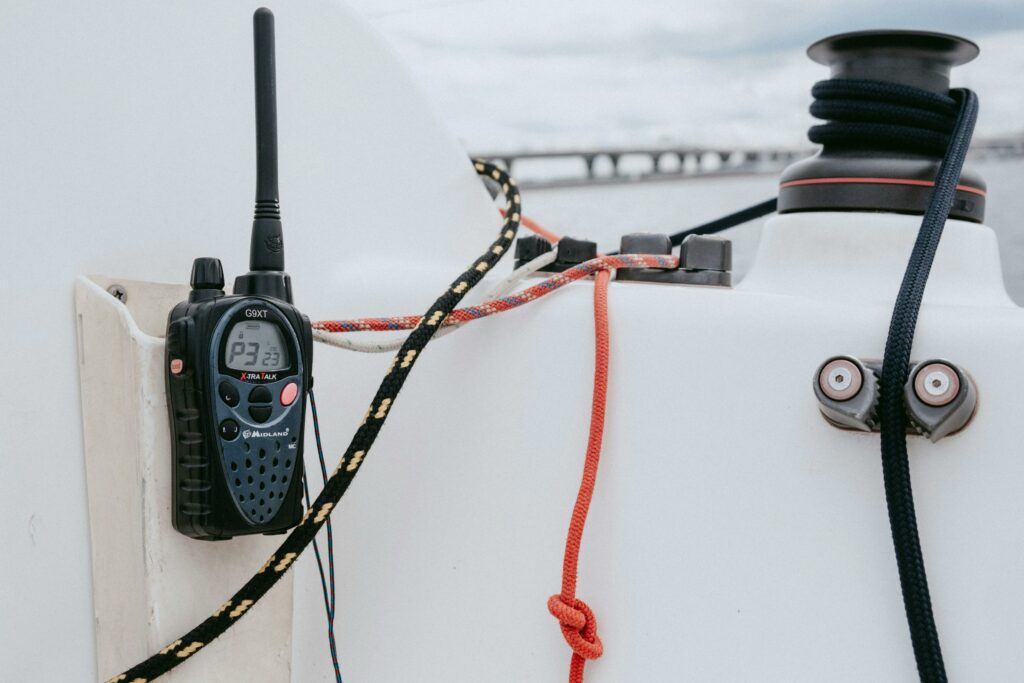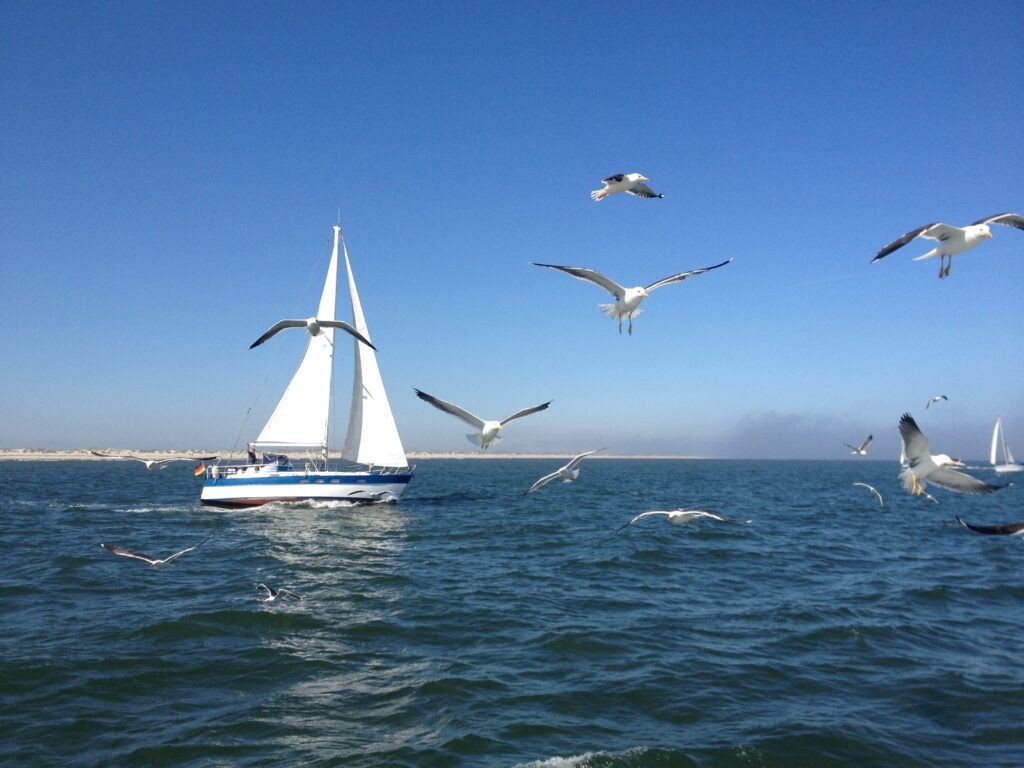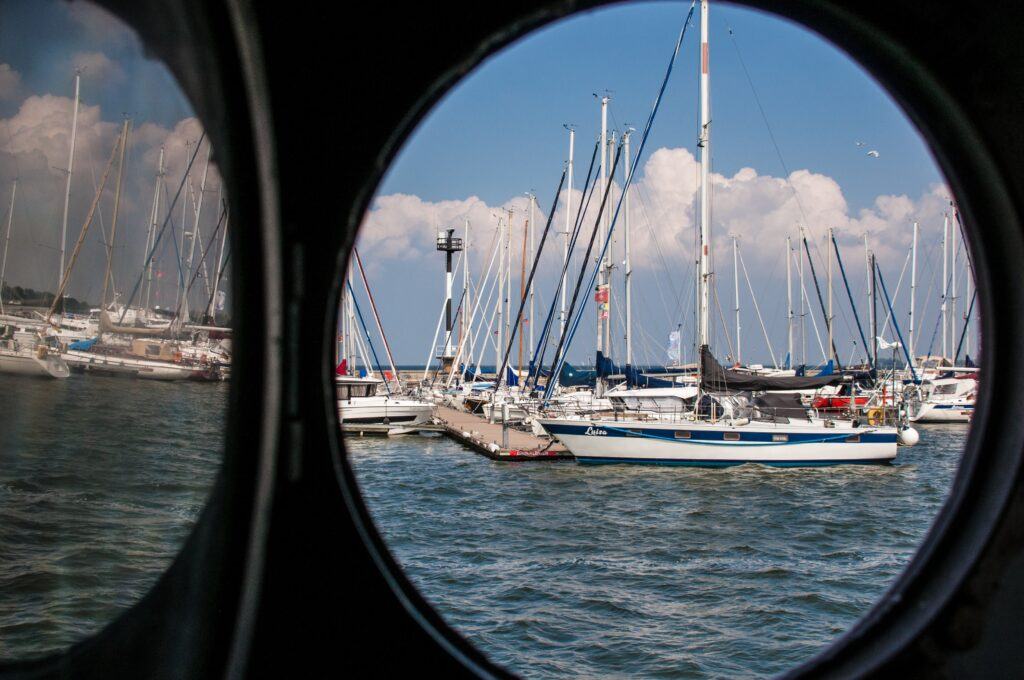
For better view click on images to expand
Set foot on a sailboat and you’ve entered a world rich with tradition, written and unwritten rules. If you’re curious about sailing culture, it’s essential to learn these tacit courtesies. Sailing etiquette isn’t just about polite behavior; it’s the silent code that ensures safety, cooperation, and mutual respect among seafarers. So, let’s set sail on this educational trek and ready ourselves for smoother sailing experiences ahead.
Right of Way and Rules of the Sea: Who Yields to Whom?
First and foremost, this knowledge is crucial for preventing accidents and ensuring smooth sailing interactions. Read NauticEd Navigation Rules: Rules for Prevention of Collision at Sea by Capt. Grant R Headifen!!!
Sail Over Power: Sailboats generally have the right of way over powerboats. However, always remain vigilant, as not all powerboat operators may adhere to this rule. Another scenario is when powerboat is restricted in its ability to maneuver, like a big container ship. That’s because large vessels can’t exactly stop on a dime or swerve like smaller boats can.
Port Tack vs. Starboard Tack: When two sailboats are on different tacks, the one on the port tack must give way to the one on the starboard tack. Simply put, a vessel approaching from your right-hand side, or ‘starboard’, typically has the right of way. In sailboat-to-sailboat encounters, the one on a port tack (wind coming from the port side) gives way to the one on a starboard tack.
Leeward Over Windward: When two sailboats are on the same tack, the windward boat must give way to the leeward boat.
Overtaking: The boat overtaking another must keep clear, regardless of whether it is a sailboat or powerboat.
Now, if the waters are crowded or if you’re participating in a regatta, always stay alert and be prepared to yield. During races, there are specific rules, and collisions are particularly frowned upon – not to mention dangerous. Always follow the prescribed course and heed the racing rules if a regatta is on your horizon.
Practical Tips:
Maintain Vigilance: Keep a constant lookout for other vessels and anticipate their movements.
Communicate: Use hand signals or radio communication to signal your intentions and avoid misunderstandings.
Avoiding Wake Damage
The wake generated by a boat can cause discomfort or damage to smaller vessels and anchored boats. Being mindful of your wake is a key aspect of sailing etiquette.
Minimizing Wake:
Slow Down: Reduce speed in areas with smaller boats, near shorelines, and in anchorages to minimize wake.
Keep Distance: Maintain a safe distance from other boats to prevent your wake from causing disturbance.
I once received a thank-you wave from a fisherman anchored near a marina when I slowed down to minimize wake as I passed by. It highlighted how a small gesture could enhance others’ experience on the water.
Practical Tips:
Observe Signs: Pay attention to no-wake zones and speed limits.
Watch Your Speed: Adjust your speed based on the type of waterway and the proximity to other vessels.
The Unspoken Dance: Anchoring and Mooring with Manners
Navigating the delicate ballet of anchoring and mooring isn’t just about finding a spot to drop anchor – it’s about coexisting with fellow water enthusiasts in close quarters. If you’re approaching an anchorage that’s already home to other boats, it’s courteous to anchor on the perimeter, leaving the center open for others who arrive. Think of it as the water’s version of not parking too close to the car next to you. Whether swinging on anchor or secured to mooring balls, consider the swing radius and changing winds. You’re aiming for enough room to avoid boat bumper cars should the weather shift. Learn more here: Maneuver and Dock Your Sailboat Under Power: High Winds, Current, Tight Marina, Backing In? No Problems! by Capt. Grant R Headifen
Anchoring Etiquette:
Anchor with Care: Avoid anchoring too close to other boats. Give enough room for boats to swing with the wind and tide.
Check Your Gear: Ensure your anchor and chain are suitable for the seabed and conditions.
Mooring Etiquette:
But what happens when you’re the new kid on the dock? Well, approaching other skippers for advice shows humility and respect for their expertise. It assures them you’re committed to keeping the peace of the anchorage. And when it’s time for you to weigh anchor, do so with minimal fuss. Give your fellow sailors a friendly wave goodbye, ensuring you’ve left nothing behind but gentle ripples in the water.
Respect Mooring Rules: Adhere to local mooring regulations and use designated mooring buoys.
Leave No Trace: Remove all personal belongings and trash when leaving a mooring.
Practical Tips:
Practice Anchoring: Regularly practice anchoring techniques to become proficient and avoid mishaps.
Be Considerate: Check the surroundings and anchor appropriately to avoid disturbing others.
Communication and Signals

Effective communication is essential for coordinating actions and preventing misunderstandings with other sailors. Signal horns aren’t there for your latest playlist; they’re a safety measure. You need to know the proper signals for fog, maneuvering, or warning other boaters. It’s not just polite; it’s a Coast Guard regulation. So, familiarize yourself with the needed honks and toots before you head out.
Using Visual Signals:
Hand Signals: Develop a set of hand signals with your crew for common maneuvers and emergencies.
Flags: Use appropriate flags to signal intentions, such as diving flags or quarantine flags.
Radio Communication:
VHF Radio: Use VHF radio to communicate with other boats, especially in crowded or restricted areas.
Channel Usage: Adhere to proper channel usage and avoid congesting emergency channels with non-essential communication.
Practical Tips:
Learn Basic Signals: Familiarize yourself with basic hand signals and flag meanings.
Practice Radio Etiquette: Learn and practice proper VHF radio protocols for effective communication.
Courtesy in Marinas and Anchorages
Being courteous in marinas and anchorages fosters a positive atmosphere and ensures smooth operations for everyone.
Entering and Exiting Marinas:
Observe Speed Limits: Adhere to posted speed limits within marina areas to prevent wake and ensure safety.
Communicate with Staff: Contact marina staff for docking instructions and assistance.
Remember, the ultimate goal is harmony on the water, where everyone feels safe and at ease. It’s not just about avoiding physical collisions but also about preventing ripples of discontent among those sharing the space.
Silence is Golden: Behavior in Anchorages and Noise Management

Now, I’m not saying you’ve got to be library-level quiet on the water, but keeping the noise down is a key piece of sailing etiquette. Imagine you’ve finally escaped the city’s clamor, you’re out there with the crisp sea air filling your lungs, and then… blaring music shatters the peace. Not the ideal scenario, right? The tranquility of the open sea is one of sailing’s biggest draws. So, when it comes to managing sound, it’s all about respect. Boats are closer together than you might think, and sound travels far over water.
Respect Quiet Hours: Avoid loud music or activities, especially during nighttime and early morning. Early mornings and late evenings are usually the quiet times on the water. If it’s midday and you’re anchored with no one around, feel free to enjoy your tunes a bit louder. Just remember, sound carries easier over water, so what might seem like a moderate volume on land could be excessive on the sea.
Practical Tips:
Plan Ahead: Contact marinas in advance to secure berths and understand their specific regulations.
Be Mindful: Be considerate of noise levels and cleanliness to maintain a pleasant environment for all.
Assisting Fellow Sailors
Offering assistance to fellow sailors in need is a hallmark of good seamanship and fosters a supportive sailing community.
Offering Help:
Observe Signals: Be attentive to distress signals or calls for help from other boats.
Assist When Safe: Offer help if it’s safe and within your capabilities, such as providing a tow or lending tools.
Accepting Help:
Be Grateful: If you receive assistance, express gratitude and offer help in return if possible.
Share Knowledge: Share your experiences and knowledge with others to contribute to the sailing community.
Practical Tips:
Stay Alert: Keep an eye on other boats for signs of trouble or distress.
Build Relationships: Engage with fellow sailors and build relationships that can lead to mutual support.
Environmental Responsibility

Practicing environmental responsibility is crucial for preserving marine ecosystems and ensuring the sustainability of sailing activities.
Reducing Environmental Impact:
Maintain Cleanliness: Dispose of trash properly and avoid discharging waste into the water.
Avoid Pollution: Never discharge waste, oil, or chemicals into the water. Use designated pump-out stations for sewage disposal.
Protect Marine Life: Be mindful of marine life and avoid disturbing habitats, especially in sensitive areas like coral reefs.
Adopting environmentally friendly practices, such as using biodegradable cleaning products, helps minimize impact on the marine environment.
Practicing Leave No Trace
Clean Up: Collect and dispose of all trash properly. Participate in or organize cleanup efforts for your favorite sailing areas.
Use Eco-Friendly Products: Opt for eco-friendly antifouling paints, cleaners, and products that minimize harm to marine life.
Practical Tips:
Educate Yourself: Learn about the environmental regulations and best practices for your sailing area.
Lead by Example: Demonstrate environmentally responsible behavior to encourage others to follow suit.
The Culture of Camaraderie: Building Community on the Water

Sailing isn’t just a sport or hobby; it’s also about being part of a community that shares a deep love for the sea. The unwritten rules of sailing help us navigate through waters, build bonds among those who heed the call of the waves. When you extend a hand to a fellow sailor, share a bit of advice over the radio, or simply greet another crew with a smile, you’re weaving yourself into the tapestry of this close-knit world.
Remember, you’re not out there alone. Consideration for others extends beyond just being courteous; it’s about looking out for each other. Bad weather, equipment failure, or unexpected situations can happen to anyone, and knowing that there’s a community you can count on can be a game-changer. I’ve seen sailors go out of their way to tow a stranded boat, offer spare parts, or provide guidance on local sailing conditions. That’s the spirit that makes sailing such a rewarding experience.
For those new to sailing, I encourage you to reach out to more experienced sailors. Most of us love sharing what we know and seeing someone else develop a passion for sailing. It helps to keep the community vibrant, knowledgeable, and most importantly, safe.
And let’s not forget the importance of passing on this culture of camaraderie. If you’re a seasoned sailor, take the time to mentor newcomers and share the traditions of the sea. Your actions will ensure that the etiquette and customs you’ve come to cherish will be upheld by future generations of sailors.
In closing, let the principles of respect, safety, and support guide you as you set sail. Embrace the camaraderie that comes with being a sailor and enjoy the vast, open waters knowing that you are part of a community that holds these values dear. After all, the memories we make and the friendships we forge on the water are the true treasures of sailing. Happy sailing!


